Victoria Sadler's Blog, page 19
April 30, 2014
Very Little Glamour on Show in V&A's Italian Fashion Exhibition
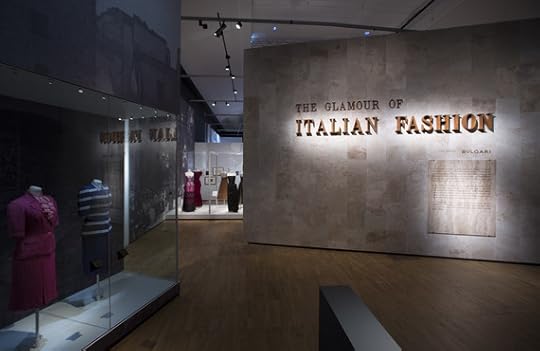
The Glamour of Italian Fashion 1945 - 2014 is the first major exhibition to explore Italy's rich contribution to modern fashion from the end of the Second World War to the present. Its intention is to emphasise how traditional Italian craftsmanship in textiles and tailoring was reinvigorated through investment via the post-war Marshall Plan, bringing growth and glamour to a country devastated by war and fascism.
There is a really fascinating story to explore here, which would really illuminate an exciting exhibition. But this hasn't happened here.
First, there are few pieces on display, which is extraordinary considering this exhibition is covering almost 60 years of a major national industry. The display fills only a few rooms and the content is spread very thinly across them.
There can't be more than 100 mannequins on show here. And compare that to the Gaultier exhibition which has close to twice that - and that's for one man.
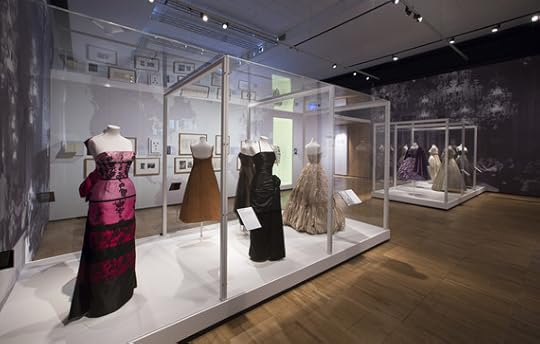
The pieces on show are also not exciting. There's a couple that catch the eye at the start of the exhibition, such as Aztec-print beachwear from Pucci's first collection and some very elegant evening dresses in lace and ruffles from early pacesetters such as Simonetta and the Fontana Sisters, but it all peters out very quickly after the promising start.
The standard for fashion exhibitions has been set very high by shows such as Isabella Blow, Gaultier and the McQueen exhibition in New York (which is transferring to, ironically, the V&A next Spring). This exhibition falls very short in comparison.
Multimedia exploration is also minimal.
I expected an army of dress mannequins surrounded with film footage of old Hollywood glamour arriving for the Oscars, catwalk shows, design sketches from these iconic fashion houses, and photos of the suits and dresses on the stars of the time. But there was very little of this on show.
And the rooms were silent. Was sound design even considered?
This is all such a surprise as in the galleries next door is the William Kent exhibition, where such attention and focus was given to multimedia, audio-visual content. And that's for Georgian Britain!
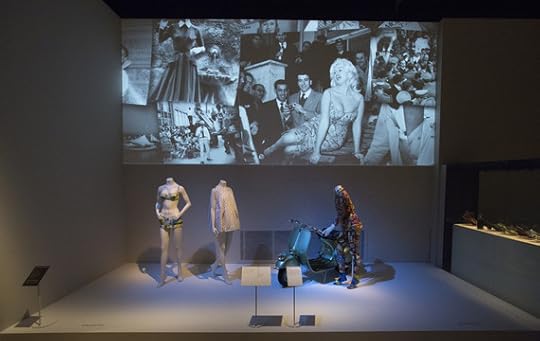
Even in comparison to other V&A costume exhibitions such as Hollywood Costumes, or the Bowie and Kylie shows, this stood out for all the wrong reasons. These shows were filled with colour and details on the exhibits were plentiful, including how these looked on the original artists they were designed for via sketches and photos.
Nor was the bland curation of the show the only issue.
Italian Fashion from 1945 to 2014 is a vast wardrobe to draw from, and it's a period that just exudes glamour, celebrities, sensual evening gowns and sharply tailored suits, celebrity designers, catwalks...
I expected the galleries not just to be packed with mannequins but also to be packed with pieces that I recognised, with pieces that screamed glamour. Not at all.
There's more Benetton knitwear on show than Valentino dresses. And instead of sharp tailoring in male trouser suits, there are dull, drab dark brown suits instead. And few pieces were familiar.
Elizabeth Taylor's Bulgari necklace, earrings and brooch set (in typical Taylor style, why just have one piece when you can have three??!!) in emeralds, diamonds and platinum were instantly recognisable as hers. But that was pretty much it.
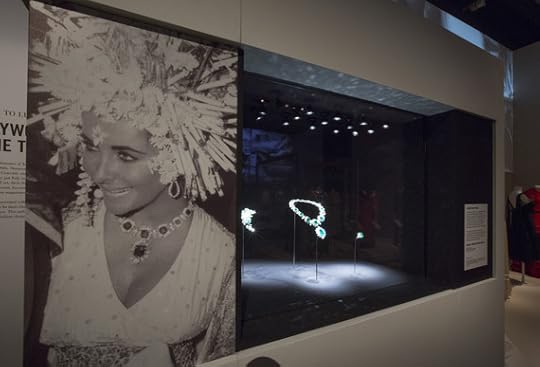
An embroidered coat worn by Maria Callas was on show but it's not a memorable piece from her wardrobe. And the dress on show worn by Ava Gardner was a very plain black wool dress. It's all a bit deflating compared to the high-octane glamour you're led to expect.
In the contemporary section in the final gallery of the exhibition, Tom Ford's white peep-hole dress I recognised, but more because it had been used heavily in Gucci advertising at the time rather than it being a red-carpet dress. Cavalli's animal-print was easy to pick-out - but again because it was distinctively Cavalli rather than being actually, well, glamorous.
And just think of all the glamour and all the celebrities associated with Gianni Versace - Diana, Madonna, Elton John, Michael Jackson, Cher - yet none of these pieces were available. Instead the Versace piece in this section is from Donatella's era for Versace.
You can't help feeling that this exhibition might have been hamstrung by not having access to as many fashion pieces as they'd have liked. If so, it's a real shame that fashion houses and other private collections couldn't be persuaded to release more, and more familiar, pieces to the V&A.
How this exhibition would have been lifted by one of Diana's Versace dresses, some of Missoni's instantly recognisable and colourful knitwear, or a Dolce & Gabbana corset from their vast back catalogue. This show desperately needed many more statement pieces from which to hang the rest of the exhibition.
It's not like the V&A to under-deliver like this - it has a well-deserved reputation for delivering high-quality showcases - so I'm ok with putting this down as a one-off. But it was a little weird exiting through the gift shop only to find the products available to buy more enticing than the exhibition I'd left behind.
Victoria and Albert Museum, London to July 27, 2014
Ticket Price: £13.50 (concessions available)
Image credits: Installation images of The Glamour of Italian Fashion 1945 - 2014 © Victoria and Albert Museum, London
Published on April 30, 2014 12:14
April 27, 2014
The Vagenda, Book Review
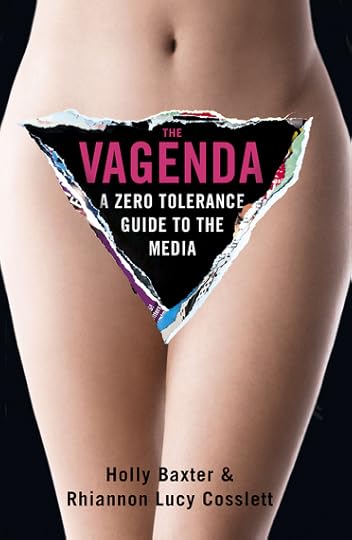
The new Vagenda book has put me in a real quandary. I dislike feminists having a go at each other rather than working together but, in all honesty, I cannot recommend this book. It's narrow in scope, outdated in its subject matter and patronising at best, offensive at worst.
So what to do? I have thought about not writing this review, returning the book to sender, fearful of the backlash I fully expect to be the response to criticism of a popular blog. But I have persevered because I believe, simply, that as feminists and as people, we deserve more than this.
So before you throw your bricks at me, please at least read the rest of my review.
In The Vagenda: A Zero Tolerance Guide to the Media (to give the book's full title), Rhiannon Lucy Cosslett and Holly Baxter take on beauty magazines, an idea marketed as "agenda-setting", which was the original idea behind their very successful blog that first appeared online in 2012.
What follows is a rather box-ticking attack on all the areas beauty magazines screw us over: pushing male satisfaction over female - check; distorting images of women - check; cultivating low self-esteem in readers - check; pushing the agenda of the fashion industry - check.
The book is written very much in the style of the Vagenda blog - chatty, colloquial - only for me it all got a bit ladette in parts. "Vag" "blowie" "shitmuncher" "or as we prefer to call male partners, 'him indoors.'" I felt I was being lectured to by Zoe Ball c. 1993.
But anyway, whatever floats your boat.
More worryingly for me was not how they wrote but what they wrote.
There is less than two pages set aside for discussing non-white women in this book (I counted the paragraphs). Two pages out of 300. And even less than that for discussing non-heterosexuality. And absolutely no mention whatsoever of the absence of transsexual women from the pages of beauty magazines.
Vagenda set aside more pages for discussing celebrity nutritionists than those for all of the above. This level of exclusion is glaring. How hard can it be to read beauty magazines avidly - as Vagenda do - and not be hit by how white and how straight beauty magazines are?
Rightly Vagenda point out the puerile content of beauty magazines, more focused on how readers should satisfy their man rather than providing interview tips for a new job. But even when you think the book is making headway, such as tackling the patronising reflection of women in the workplace, Vagenda add to the problem with comments such as the following:
"Granted, most successful anythings are men (with the possible exception of burlesque dancers)."
Just take the full impact of that sentence in, just for a moment.
Just take it down, that a feminist would make such a comment. And, of course, the now-seemingly obligatory diss at burlesque dancers, just for good measure.
And too often the authors put a 'fact' in the text, but without any footnote on the source. "Cosmopolitan, a magazine which 90% of young women in America reportedly look to as a significant source of sexual education" is just one of way, way too many examples where the source of this data is omitted.
And then when these 'facts' are elusive, Vagenda just stated their own opinions as facts instead. "Women aren't staying away from porn in 2014 because they don't care for sex... they're staying away from it because it's just another tiring male-dominated sphere that has absolutely nothing to do with female pleasure."
Really?? Where did this fact come from? I've not heard of a single report which proves women are staying away from porn - for whatever reason - let alone for the reasons stated.
And despite running an incredibly popular blog, there are scant contributions from readers. You can count on one-hand the number of readers' experiences that are mentioned. It seems bizarre that given Vagenda have a great opportunity to get feedback from their readers, they have chosen not to do so. Instead it's 300 pages of opinions - their own.
This absence of quality data, contributions from the wider public and its narrow focus on white, straight women born with a vagina reflect the extent to which this book really just is a few blog posts stretched out very, very, very thin.
There simply isn't enough quality content in this book to justify it being made at all, let alone marketed as "agenda-setting". I feel embarrassed for Naomi Wolf in even mentioning the mighty The Beauty Myth in the same article but her book is miles, miles, miles better.
The Beauty Myth was truly an agenda-setting book. Twenty years later, this book brings absolutely nothing new to the table, which brings me on to my other main concern about this book - the central subject matter simply isn't relevant.
The Vagenda website received 7million hits in its first year, a readership which simply dwarfs the dwindling circulation of beauty magazines (here's an actual fact for you - Cosmo's readership dwindled to about 300,000 per month in 2012).
We're ditching the beauty magazines and heading online. This book isn't relevant by about 10 years. It's tackling an archaic subject matter. And as the folding of Nuts has proved, even when the beauty magazines collapse, the issue doesn't go away. The real battleground for the Vagenda generation is the internet.
But there's also another way to analyse the popularity of Vagenda.
In their really quite patronising style, Vagenda think their book is riding to the rescue of a population of naïve women too stupid to realise how the magazines are chipping away at their self-esteem. "Girlfriend, trust us - you are so much more than a spare willy with a comedy face painted on the end" being a stand-out example.
But actually we're not that stupid and indeed, the popularity of their blog should've proved to Vagenda that their generation is fully aware that they are being peddled patronising and insulting crap by these magazines.
They too are looking for alternatives to feed their interest in fashion and entertainment without having their self-esteem crushed in the process.
Then there's the slagging off of other women in this book that makes me very uneasy.
"As Kim Kardashian has regularly demonstrated to us, simply being a female with an arse has become a noteworthy occupation." Any feminist worth their salt shouldn't be criticising another woman for making a career the best way she knows how in a patriarchal structure which has distorted her value system - blame the game, not the player.
And if it's not Kim, it's women who actually like pretty knickers. "Who exactly is this lacy lingerie actually intended for. Not us, surely? Oh, that's right, it's for men." And then a few pages later, in a swipe at corsets "Undergarments have always existed for the benefit of men."
These judgmental and naïve comments undermine the confidence of every young woman who's at home thinking, I really love my lacy knickers, as well as completely insulting pretty much the whole of Vivienne Westwood's fashion history.
Then in a section on working women, there's an eye-watering dismiss of mumpreneurs as "a mother who also sometimes sells stuff" and an observation that "no wonder so many women are setting up their own patchwork oven glove companies and becoming their own bosses." What??!! Are you serious?!!!
So anyway, if Vagenda hate beauty magazines so much (and actually I do too), what do they want us to do about it?
I was at least hoping for a rallying call to arms, a demand we boycott these destructive publications. That would be in line with the title of "zero tolerance." Only that's not actually what Vagenda want.
In an interview distributed with the book, Cosslett backed away from calling for a complete boycott. "I don't think it's about destroying the whole magazine industry. It's about demanding more from magazines. Demanding more, because we deserve more."
I couldn't believe it. Where's the "zero tolerance" so wilfully flagged in the title? Because zero tolerance means radical action. And what on earth does "demanding more" actually mean, in practice?
Vagenda's response is frustrating as if magazines are battling to stay afloat, then readers have immense power. Radical action such as a full boycott of one or all magazines for a period of time would force the hand of magazine editors very, very, very quickly.
I just couldn't fathom why Vagenda would be so compromising. Then I saw it, in the Acknowledgements at the back of the book. "To everyone at Elle who, despite being a women's magazine, were chilled enough to still want to work with us on a brilliant feminist campaign."
Oh, Vagenda. What is there to say to that?
And I've gone way, way over my word count and there's so much I didn't touch on, like the cover for example. I think Vagenda think they're being subversive by using such a tired image of a slim, white women's vagina torn out. I think that level of naivety pretty much sums up what's going on between the book covers too.
I wish Vagenda luck in all their work going forward but this is not an agenda-setting text for fourth-wave feminism. We all deserve and need more than this - much more.
Image credit: The Vagenda: A Zero Tolerance Guide to the Media, Cover Image © Random House
Published on April 27, 2014 16:00
April 24, 2014
Theatre Review, Privacy: Frightening Impact of Mass Surveillance Laid Bare

Privacy is a really sharp, relevant play that looks at the frightening impact of mass surveillance. By addressing this vital issue head on, Privacy is unequivocally a play for our time.
Snowden's whistleblowing has transformed cultural discourse on this. We are most definitely in a mass surveillance state - this isn't just the stuff of Orwellian nightmares. And more than just being watched, your behaviour is being analysed to predict your actions and desires even before you've thought of them yourself.
In this dramatic, electrifying play, we are invited - no, demanded - to face up to the impact of this surveillance on our lives. The trail we leave on the internet now is more profound than what we think. And it's not just the obvious social media websites that we need to worry about.
Think you're ok because you don't do online shopping and you just shop instore? Think again. Think you're not affected because you just use secure wi-fi? Think again. Think Snapchat is ok because it just self-deletes? You most definitely need to think again.
To prepare this play, writer James Graham (the talent behind the 2013 hit at the National Theatre, This House) interviewed a whole raft of people from judges to politicians, from spies to kids, to gauge what this means for us.
Excerpts from those interviews have been weaved together into this verbatim interactive drama, which examines how we are being monitored today.
The audience is invited to leave their phones on and to walk the walk. Together, cast and audience investigate what it is about ourselves that is being gathered and analysed in remote data centres and spy agencies, even as we sleep, and how they are doing it.
In isolation, a lot of the info is not news (thanks to Snowden) but Privacy excels in demonstrating how, when all pulled together, we are now caught in a frightening web.
There's not much of an actual story to speak of in Privacy - more a fascinating dramatized lecture. Nevertheless I thought it was a really well-written, dynamically produced piece of theatre that held my attention.
The loose structure is that Writer (Joshua McGuire) is commissioned by Director (Michelle Terry) to write a play on surveillance. The two are supported by six other actors who play a myriad of characters - some we know (Alan Rusbridger, William Hague, Shami Chakrabarti), some we don't (anonymous whistle-blowers, teenagers sharing their lives on social media) - who bring to life Writer's path to completing his project.
The play is superbly directed by Josie Rourke, Artistic Director of the Donmar Warehouse. The production is dramatic, yes, but there are plenty of light-hearted moments and the play fizzes with energy.
The production design team (Lucy Osborne, Duncan McLean, Richard Howell, Christopher Shutt) has done an amazing job on this show too. It's bold and a perfect companion for the show. The back of the stage is covered with projections of human fingerprints and over it, search engines, google maps and social media trails are flashed up, dramatizing the all-seeing eye and ever-encroaching hand of the State - whether that be the governments or the corporates who provide them with our data.
The play is long at 2h45m (and perhaps might benefit from losing perhaps an extraneous 15 mins from the second half) but the deft combination of humour and audience interaction, as well as drama, keeps you attention.
For me personally, I wouldn't say that I had a great awakening from this production. Like I say, a lot of the stuff I already knew (like most definitely keeping location services on the iPhone switched off) but that wouldn't stop me from recommending this play. I think it is incredibly important that we all understand the repercussions of the new surveillance state.
However for me, I'm more interested in, where do we go from here? How are we, individually and as a society, going to respond to this? Will we rise up and demand change? Will we fight back? Or will we keep our heads down and self-censor our behaviour?
It's an interesting point that is only touched on fleetingly in the play via an excerpt from an interview with Annie Machon, a former MI5 operative.
Of course we don't know how we will react. The next generation will be the first to grow up where their past will follow them every day for the rest of their lives. What they post on Facebook when they're 16, what they send to mates on Snapchat when they're at school, will be written in permanent ink on internet sites (whether they think they've deleted it or not) till the day they die. They will never be able to escape past indiscretions or stupid mistakes they made as kids.
I fear that in response to mass surveillance we will adapt our behaviour to keep out of trouble. Our instinct will be to curb how we express ourselves, how we communicate to the world, how we (mis)represent ourselves. And I fear that because once the self-censorship kicks in, that's when the State will have already won.
Donmar Warehouse, London to May 31, 2014
Image Credits: Joshua Mcguire in Privacy at the Donmar Warehouse. Photo by Johan Persson
Published on April 24, 2014 04:41
April 23, 2014
Handbagged, Review: Maggie and Liz - Handbags at Dawn
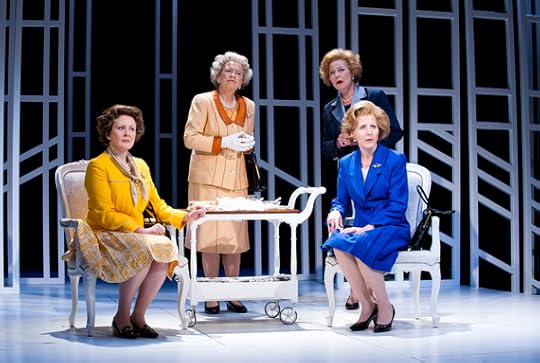
Handbagged is a magnificently funny dramatization of the clash of personalities between the two most iconic Brits of my lifetime - Margaret Thatcher and Queen Elizabeth II.
Loved and loathed respected and reviled but both women are so instantly recognisable in almost every aspect of their appearance, mannerism and even politics. Yet this well-crafted production avoids the clichés and pitfalls of caricatures to create a genuinely laugh-out loud comedy that brings out the clash of personality, politics and power wonderfully.
The play is based around the ritual weekly meetings between monarch and Prime Minister, a practice that is meant to be an opportunity for both to confide and consult (as well as be consulted). It's a dramatic setting that allows for these two women to reveal themselves - intentionally or otherwise - as well as giving a great sense of intimacy.
These meetings were of course the basis for another recent West-End show and I was fearful that this could be 'The Audience without Helen Mirren.' I couldn't have been more wrong. This play was effervescent with humour and energy, and the acting was also of the highest calibre.
As well as being a comedy, writer Moira Buffini avoids too much of a direct comparison with Peter Morgan's drama by adding the presence of both an older Maggie (Stella Gonet) and an older Queen (played by Marion Bailey who is so good, you think she could be the real thing) as ever-presents on the stage.
These two women watch over their younger selves like hawks, correcting and embellishing their dramatization as they go. A special mention must go to Fenella Woolgar as the younger Maggie, who caused jaws to drop with just how accurately she portrayed the PM's phrasing, her tilt of her head, and that calm but ever so patronising tone of voice. Awesome. And frightening!
It sounds like a nightmare combination - two Maggies and two monarchs - but the resulting crossfire of wit and wry observation is wonderful.
The Queen is known for having a really wicked sense of humour, and that is brought out here so well, especially as it crashes against the rocks of the humourless Thatcher. Yet Thatcher is rarely outplayed in repartee and it's left to the Prime Minister to point out to her seemingly left-leaning monarch that she is the only socialist who doesn't pay tax.
As this play leads us through the twists and turns, the highs and lows, of Thatcher's (many) years in office, it is funny, yes. But this is a very intelligent play that also weaves in moments of real poignancy, real pathos.
As the two icons exchange their experiences - their pain, their loss and their suffering - at the hands of the IRA with the bombings of both Mountbatten's yacht and at the Conservative conference in Brighton, you sense a moment when these two women finally connect.
It also addresses the violence and the injustices of the poll tax and the miners' strike with as much truth and honesty as the wit and humour it brings to Thatcher's exaggerated curtseying and her loathing of her visits to the Queen's residence at Balmoral.
The direction from Indhu Rubasingham is so nimble, so deft that these moments of poignancy hang just long enough for us to feel them before the production zips back into its fabulous witty verbal sparring.
The four women in the cast are ably supported by Neet Mohan and Drop the Dead Donkey's Jeff Rawle, who play a myriad of supporting characters including Dennis, Geoffrey Howe, Prince Philip, Arthur Scargill, Ronnie and even Nancy Reagan.
There's a real indulgent pleasure in watching these two icons go at each other hammer and tongs. Yes, most of us will know the ground this play treads and the stories it tells but there's something warm, something comforting about that familiarity.
I would recommend this show in a heartbeat. The writing was tight and the show kept up a great pace through its 2h 15min running time. I was completely immersed.
A quick thought though for anyone, like me, who plans to go as a last-minute thing. I hadn't bought tickets in advance and baulked at the top ticket prices of £70 and £50. At 6pm, I was able to get top price tickets for only £30 from the TKTS booth in Leicester Square. 4th row.
A great show and a wonderful evening's entertainment. Originally a Tricycle Theatre production, its West-End transfer is well-deserved. A definite go-see.
Vaudeville Theatre, London to August 2, 2014
Image credits: Handbagged at Vaudeville Lucy Robinson (Liz) Marian Bailey (Queen) Fenella Woolgar (Maggie) Stella Gonet (Thatcher) photo credit Tristram Kenton
Published on April 23, 2014 05:07
April 13, 2014
A View From the Bridge, Review: 'Gut-Wrenching, Heart-Breaking, Perfect'
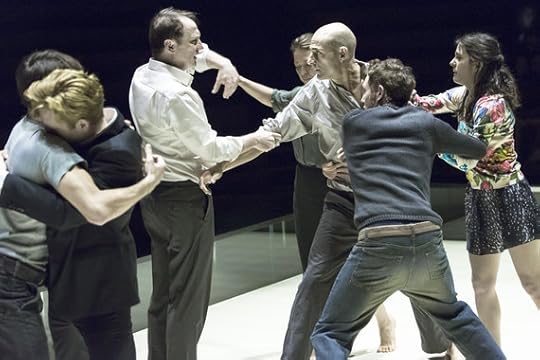
Image credits: Cast A View from the Bridge at the Young Vic, Photo by Jan Versweyveld (c) Young Vic Theatre
It's brave at any point to say that one show, one production, is unequivocally better than any other but as I write this the Olivier Awards are doing just that. So I am going to stick my neck on the line and say that, right here, right now, A View from the Bridge at the Young Vic is the best show in London.
Written by Arthur Miller in the 1950s, A View from the Bridge is the story of Eddie (Mark Strong), an Italian-American dockworker, who agrees to house two illegal Italian immigrants. Yet when one of these men, Rodolpho (Luke Norris) takes a shine to his niece, Catherine (Phoebe Fox) who Eddie has been like a father too since his sister died many years before, Eddie finds himself taking more desperate steps to keep his niece to himself.
The play is set in 1950s America, a time when illegal Italians fled a homeland destroyed by war and fascism, for the promise of a future in the States. But how this resonates with us now when we see such political points gained from threats to root out illegal immigrants in the UK today. It touches very close to home indeed.
Yet at the heart of Miller's play is a man who pays a terrible price for a series of awful decision to hold on to something he has no right to control.
This production completely captured the confusing, constantly shifting morality in Miller's writing. Eddie's feelings for his niece are completely inappropriate. It was so awkward, almost painful to watch the interaction between this grown man and his 17 year-old niece. The way they touch each other, even look at each other, is so awkwardly painful you just want to look away.
Yet we feel such anguish, such sorrow for Eddie as he betrays the men he swore to protect. His complex motivations - a desire for his niece as much as a desire to protect her - may be difficult to detangle but no man deserves the price he pays - the inevitable price for betrayal in the Italian community.
Mark Strong is simply awesome, just incredible. Physically he dominates the stage but within this proud Italian man, Strong suppresses such a tight bundle of emotions, such anger barely contained. Softly spoken but the fear he triggers in others is practically palpable.
And Nicola Walker as his wife, Beatrice, is just superb. She treads her character's fine line with such perfect balance - so desperate but yet too scared to confront her husband over why his feelings have transferred from her to Catherine.
The dynamic between Walker and Strong is profound and intense, jumping in a split second from anger to compassion, giving the production such tenderness as well as such tension.
It's hard to go wrong with writing this good but director Ivo Van Hove made some brave decisions.
The set is harsh in its sparseness - a simple slate grey and white stage framed with a glass bench. And other than a brief appearance from a wooden chair there are no props to speak of. Instead, poured onto this blank canvas are the blood and guts of these desperate characters. It's quite something.
I've seen a few excellent shows this month but A View from the Bridge got my only standing ovation. This production is simply faultless. Gut-wrenching, heart-breaking, perfect. It's impossible for me to recommend this enough. Please go see it.
Young Vic Theatre, London
To June 7, 2014
Published on April 13, 2014 10:06
Andrew Scott in Birdland, Review
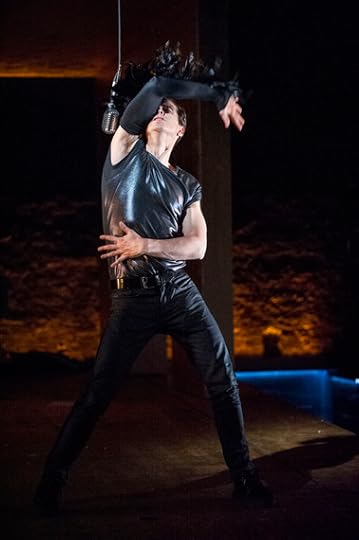
Image credits: Andrew Scott in Birdland Photo by Richard Hubert Smith (c) Royal Court Theatre
Birdland is a warning on the perils of fame. That makes it very much a tale of our time but though the bold, exciting presentation from director Carrie Cracknell and the star casting of Andrew Scott catches the eye, this play doesn't really bring anything new to this well-worn subject.
Paul (Andrew Scott) is a rock star in a world of drugs, sycophants and indulged narcissism. He is denied nothing and he is surrounded by enablers only too willing to support his habits for the sake of their own (usually financial) ends. The only exception is the support and companionship he gets from his best friend, Johnny (Alex Price)
So yes, the fast living is all present and correct - Paul shagging groupies, Paul taking drugs into the eyeballs, Paul frittering away obscene amounts of cash - but it's all quite tame really, especially when compared to the legends of the Stones and Led Zeppelin. Hell, it seems tame compared to Justin Bieber. We're all so used to this now that nothing in this play is particularly shocking.
But with no restrictions on his behaviour, Paul seduces then discards Jonathan's girlfriend - Marnie (Yolanda Kettle). Afterwards he decides it's best to tell Jonathan what's happened, only to rid himself of his own sense of guilt. But Marnie is so distraught, so terrified, she commits suicide.
From here, the play meanders through the remaining dates on Paul's long world tour with the supposed tension coming from the ifs and whens of Paul's promised confession to his friend who is desperately mourning the loss of his girlfriend - and what that will do to the only genuine relationship in Paul's self-obsessed existence.
Simon Stephens' conversational script has some interesting observations on value systems and some witty repartee around ordinary subjects such as peaches and osteopaths but it lacked a tension to drive the story through to its climax.
Andrew Scott is unequivocally the most engaging part of this production. Famous for bringing an interesting spin to Moriarty in Sherlock, he plays with expectations here again, choosing to play Paul more as an errant spoilt brat with no barriers, rather than an obnoxious rock star. There's almost a manchild element to Paul, an arrested development. It's a fascinating, intriguing approach.
It works well in those moments, when the effects of the drugs briefly recede to reveal a loneliness, a vulnerability that is usually masked over, suppressed. Paul is a man desperate to find something, someone meaningful in his life. But no sooner do we get that brief glimpse of humanity then the ego kicks back in and the arrogance returns.
The segues between Paul's life on stage and off are brilliantly done with bursts of music and some pretty rock god moves from Mr Scott but there isn't much else to get interested in until the end when Johnny and Paul are finally reunited in a scene alone - a climactic scene which is undoubtedly the best in the show, full of anguish.
Like her previous production - Blurred Lines at the NT Shed - Carrie Cracknell brings a really bold directorial vision to this show. And like Blurred Lines, the fusion of music and movement with the script really brings the piece to life. However there are some odd choices such as a gradual flooding of the stage in a watery black ink.
Overall you'll be entertained by Birdland but it won't leave much of a lasting impact. The stakes are so low for Paul, for any of the other characters, that the play just sort of meanders along. And given the subject matter was nothing new, I wasn't really sure what I was meant to take away from this.
That was pretty much summed up by a couple who were sitting behind me on the bus on the way home. They had also been at the Royal Court. After the exchange of a couple of sentences on the play ("that was a bit pointless wasn't it?" "Didn't really understand why all that black ink") they started to talk about something else - Mo Farah running the Marathon. It didn't leave a lasting impact on them either.
Royal Court Theatre, London
To May 31, 2014
Published on April 13, 2014 06:03
April 11, 2014
King Charles III Review: 'Provocative, Bold and Brilliant.'
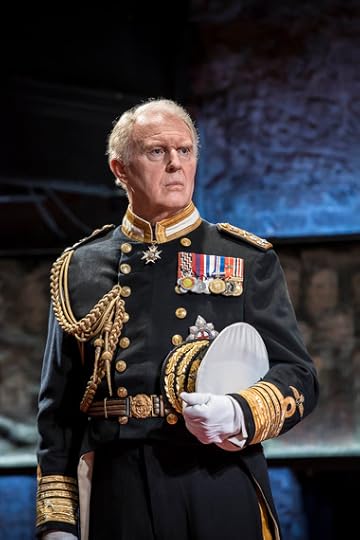
Image Credits: Tim Pigott-Smith as King Charles III by Johan Persson (c) Almeida Theatre
What will Charles be like as King? We don't know for sure but many fear it. And we get a dark forewarning in King Charles III, a provocative and controversial future-history play at the Almeida Theatre.
Set in the very near future, Queen Elizabeth has died and Charles (Tim Piggott-Smith) leads the familiar mourners- William (Oliver Chris), Kate (Lydia Wilson), Harry (Richard Goulding), and Camilla (Margot Leicester) - at her funeral. But as soon as the ceremony is over, Charles is required to continue the duties of a monarch by signing into law a divisive new privacy bill that seeks to limit the freedom of the press.
Royal Assent should just be a matter of routine but Charles refuses. He believes himself to be taking a principled stand, to be defending the freedom of his subjects, but inevitably it plunges the country into constitutional crisis.
The writing from Mike Bartlett is sharp and current in content. He knows the technicalities of our constitutional monarchy well and all the worrying idiosyncrasies of our unwritten constitution are laid bare.
Yes, parts of this production are exaggerated for theatrical purpose - I'm no fan of Charles but even I think it's unlikely that within two weeks of his mother's death, Charles will have dissolved Parliament and have put tanks on The Mall - but it is necessary for the theme of the story to be made,
What will really surprise you though is the style of this play. It is a Shakespearian tragedy in tone, structure and even writing. By adopting such a style, Bartlett cleverly implies that Charles III will be another example of the tragedy of kings that Shakespeare mined so beautifully in his history plays.
In this production, Charles is a King undone by his own desire to rule, rather than reign. And in true Shakespearian style, it is the tragedy of the man that he wants so much to be King when he is clearly so patently unfit for the role.
And there's plenty of Shakespearian treachery, plotting and family betrayal. There are even ghosts, soliloquies, using the audience as confidantes and a rather surprising Lady Macbeth.
The Shakespeare nods even go down to the words with plenty of rhyming couplets and verse. You do have to adjust to William and Kate talking in phrases such as "Kate, what on that paper makes you look?" and "Tell me about this letter brought" but it's all cleverly done.
Credit is due to the whole cast for their performances. The fine line between acting and caricature is desperately hard with persons we are so familiar with. All of them were excellent.
It may be no surprise that a lot of the comedy came from Harry (a perfectly pitched performance from Goulding) but Lydia Wilson as Kate Middleton was excellent, bringing depth and ambition to a woman we see in such a passive role on our screens and in our papers. Adam James is also excellent as the robust Prime Minister quite prepared to go toe-to-toe with the King.
Obviously, Tim Piggott-Smith stands out as Charles - he is such a superb actor. He keeps the obvious affectations such as the hand-wringing and the awkward body language, but fleshes him out with a man as much ill at ease with himself as he is with others.
This production may not be completely perfect - losing 15 minutes off its long running time wouldn't be hard - but the challenge is more for the audience rather than looking to amend the show, which is an interesting turn of the tables.
For the first 30 minutes or so, there was plenty of nervous laughter in the audience, many of whom were unsure what to make of what they were watching. Certainly the haunting wanderings of Diana's spectre led to more suppressed giggles than dramatic gasps. But soon we were all enwrapped in the drama and it is a reflection of the quality on show that by the end we pitied Charles as much as we loathed him.
The style of the whole production is controversial but what a breath of fresh air. Mike Bartlett's writing is brave and Rupert Goold's direction is provocative, yes, but you have to applaud them for taking such risks.
It would have been so, so easy to tackle this subject matter through a more straightforward drama. Director Rupert Goold took a big gamble in choosing to adopt such a provocative style, knowing that it might (and probably will) divide audiences.
But if theatre is going to survive, even thrive in such a competitive world of entertainment, it needs to be brave and relevant. It needs to take risks. King Charles III is a massive, massive risk - which really plays off. I loved it - moving, relevant, controversial and superb.
Almeida Theatre, London
To May 31, 2014
Published on April 11, 2014 03:06
April 9, 2014
Review: Alan Ayckbourn's A Small Family Business at National Theatre
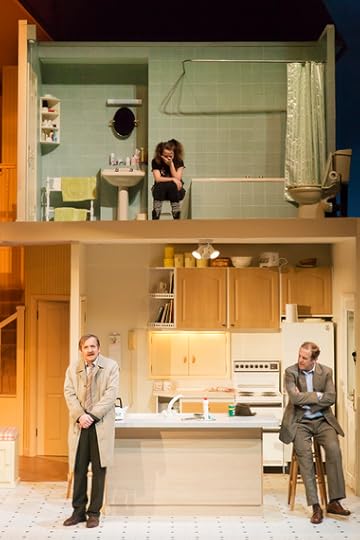
Image credits: upstairs - Alice Sykes - Samantha McCracken, downstairs Matthew Cottle -Benedict Hough, Nigel Lindsay - Jack McCracken © Johan Persson National Theatre
Written by Alan Ayckbourn, A Small Family Business at the National Theatre is a comedy about an honest man corrupted by his family's dishonest ways. Jack McCracken (a terrific Nigel Lindsay) has left his office job of many years to take over from his father-in-law in the family's struggling furniture business. But no sooner has Jack started in his new role then it all seems to come apart.
A mysterious private investigator, Benedict Hough (Matthew Cottle) turns up unannounced at the family house on the pretence of charging Jack's teenage daughter with theft of a £1.87 mascara from a local shop. Only he actually has compromising information on the family business, which he threatens to use as a bargaining tool with Jack in exchange for dropping the charges against his daughter.
Refusing to be blackmailed, Jack races against time - and Mr Hough - to find out the truth of his family's behaviour. And what he finds sends him reeling. But protecting the family and acting with integrity cannot both win in this set-up so which will it be - anything to protect the family or anything to do the right thing?
This is played as a high-energy dark comedy and there's certainly plenty of japery, even farce. As Jack scrambles through the myriad of arrangements between family members who are all out to make a little (or a lot) on the side, there are plenty of comical revelations to be had.
Each family member is given a shtick for comedy value - the married woman with her series of Latin lovers the dunce of the family, the old head of the family bumbling with dementia (is that a source of comedy???), the carer with sticky fingers, the wife more obsessed with her cute little dog than her husband, and so on. It's all very one-dimensional.
But what sets this apart from more usual farcical fare is the very dark undercurrent to this story.
Matthew Cottle really stands out as Benedict Hough, the chilling, insidious private investigator that always seems to be one step ahead of Jack. But Alice Sykes also shines as Sammy, the difficult teenager. This role easily fits into the one-dimensional tag that blights all these roles but Alice brings a tender pathos to her troubled character.
But this production, for me, has more problems than just the simplistic characterisation. This Ayckbourn play originally debuted in 1987 and it really does show its age. This is very much a play about the 1980s, about the corrupting influence of capitalism, of greed and therefore, of course, Thatcherism.
"Theft is theft is theft" Jack booms at the start, when he finds out about Sammy's shoplifting, And his move away from such a black and white stance is the driving theme of this play.
But capitalism isn't really anything new to us today. If anything, we are beyond that, dealing with how we are going to correct the damage it has inflicted. As a result, A Small Family Business very much seems a play of its time. It doesn't shed any light on our society today.
It's not helped by the fact that the whole production is set in the 1980s with plenty of permed hair and shoulder pads.
And I didn't really warm to the set design. The large interior of a house has been recreated on the stage, enabling a lovely myriad of scenes between a variety of characters to take place simultaneously in different rooms, contributing to the energy, but the house itself - a red-brick suburban new-build from the 1980s, had quite a doll's house feel to it that only emphasised the artifice.
The play also comes in at about 2h 45m, which is a long running time for a play that is supposed to buzz with energy. It does drag a bit in places, causing the buoyant energy to deflate too much at times.
But if you've already got tickets, don't be too put off. The cast really give it their all and there are plenty of laughs to be had. However if you haven't bought tickets yet, I'd suggest you'll find more relevant shows elsewhere. Nevertheless, this play is an interesting, enjoyable experience, though maybe not a challenging one.
But if you'd like an evening watching this witty farce but wish it were a bit cheaper, the play is being broadcast as part of NT Live in cinemas on June 12, 2014. I'd advise that this might be better value for money than the top-price tickets of £50.
National Theatre, London
To August 27, 2014
Published on April 09, 2014 05:04
April 8, 2014
Gaultier! Gautier! Gaultier!
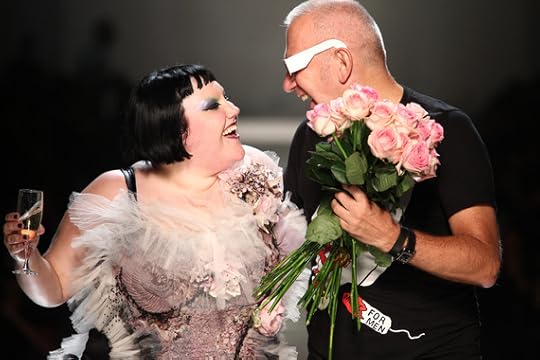
Image credits: Rock'N'Romantic collection Women's prêt-à-porter spring/summer 2011 Model: Beth Ditto, lead singer of the band Gossip © Patrice Stable / Jean Paul Gaultier
The Fashion World of Jean Paul Gaultier is the first comprehensive exhibition of the work of this celebrated enfant terrible of fashion. And it is a vast, extraordinary exhibition full of iconic celebrity pieces and sexually provocative fashion.
Jean Paul Gaultier is arguably one of the most important fashion designers of recent decades and the full scope of his work is on display in this show at the Barbican Centre, a show so encompassing it covers two floors.
Always considering himself a rebel, Gaultier constantly looks to shake up societal and aesthetic conventions. And always a non-conformist, Gaultier deliberately cultivates models across all genders, race, ages and body shapes, as well as looking to street style to influence his couture line.
As Gaultier says in a quote in the exhibition, "As a child, my attention was always drawn to these women who didn't look like everyone else." Certainly so much of his work encourages individuality and freedom of expression.
As you walk into the first few rooms of this exhibition, that variety and freedom is everywhere - from pleated leather skirts to a Breton-striped lace dress, from an exquisitely jewelled hinged corset, to Chinese-embroidered thigh-high boots. There really is something, some piece that you will be drawn to.
The recent Isabella Blow exhibition at Somerset House set the standard for fashion exhibitions with its multi-media approach and that is adopted here. The army of dressed mannequins is supplemented by fashion photography from the likes of Mondino and Stéphane Sednaoui. And video reels of Gaultier's colourful fashion shows run on loop.
Gaultier's much-coveted and much-adored stage and screen designs are also brought to life with footage of his muses wearing his designs including Kylie, Beyoncé and Milla Jovovich from The Fifth Element.
And where the dress mannequins in the Isabella Blow exhibition were all customised with Blow's signature red lips, here they are facially animated with film of real faces projected onto them. It's innovative, for sure, but it can be a little freaky!
Whereas mannequins usually have blank faces, these ones are fully animated with moving eyes that follow you around the room like some living, breathing Mona Lisa. Indeed even Gaultier himself gives a monologue from one of the mannequins with his face projected onto a plastic model wearing his familiar Breton-striped jumper and punk-rock kilt.
But the main draw is, of course, Gaultier's collaborations with celebrities - and most notably, Madonna.
Yes, that corset is here - and in touching distance (though that's as close as you're allowed!). I don't think either Madonna or Gaultier have had a more notable moment than the gold conical bra corset he designed for her Blond Ambition tour - the image defines them both - so it is great that this iconic piece has been made available to the exhibition. Well done curators!
Up close, you realise this gold corset is a very simple but perfectly designed piece. Structured at the front to give that highly-stylised look, it is also fully flexible to allow for Madonna' energetic choreography. And nor was this their only collaboration.
As the dozen or so sketches alongside testify, the two have worked closely ever since. A more recent corset from the singer's MDNA tour is there as well as a very famous pinstripe wiggle dress that the singer wore on his catwalk - complete with fully exposed breasts.
Madonna and Gaultier has been a mutually beneficial and long-lasting relationship. You sense they are like-minded individuals - both eager to pioneer and provoke. As the Madonna quote in the exhibition testifies: "Gaultier is different because he likes taking risks - sexually provocative but light-hearted." Just like the lady herself.
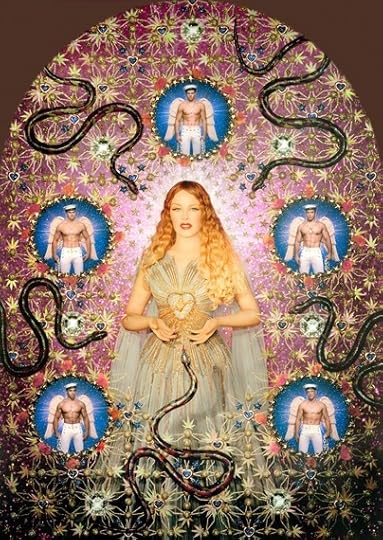
Image credits: The Virgin with the Serpents (Kylie Minogue), 2008 Virgins (or Madonnas) collection, "Auréole" gown. Haute couture spring/summer 2007 Sky blue pleated tulle gown with "rays of light" gold lame appliqués, long panels floating from the shoulders in the back Painted photograph, framed by the artists 181 x 137 cm (framed) Gallerie Jérome de Noimont, Paris © Pierre et Giles. Courtesy Gallery Jérome de Noimont, Paris
There is more to Gaultier though than his showmanship. His couture work reflects not just his craftsmanship but his incorporation of many fabrics and cultures - the jewelled wedding dress worn with a huge, elaborate white feathered Native American headdress, or the intricately beaded Islamic veil shown with a thick Sherpa-style coat.
His work with Chantilly lace, a nightmare fabric to handle as it's so easy to tear and mark, is a real highlight of the exhibition. Paired with bondage leather jackets, black feathers and masks, these dark romantic, very sexual looks are showcased in mini-bordellos on the upper floor, complete with red lighting.
In addition to this craftsmanship, I am also a fan of the way Gaultier has challenged politics with his clothes.
Corsets have been seen as both vehicles of symbolic and literal repression of women, with their tight-lacing confining and constricting women. Of course to Gaultier, these corsets are symbols of female sexual power but I thought an interesting variation was the corset he designed for expectant mothers. Historically corsets were used to suppress the baby bump - here, it is emphasised in exaggerated glory.
The prêt-à-porter pieces though were, for me, not as successful. Pieces such as the long jewelled sheath dress complete with large Eiffel Tower design, and the trouser suit with heavy pleating from the thigh downwards were not Gaultier at his finest. It's as if you can feel the guy is hemmed in, frustrated by the lack of freedom.
Only in the couture and the stage work is Gautier's creativity given full reign and that's really where the strength of this work and this exhibition lie.
As former mentor and employer Pierre Cardin says, "You are a true designer when people recognise your work without even looking at the label. This is the case for Jean Paul Gaultier." And in his high-end box-office draw pieces, that's where you look and say - Gaultier!
Barbican Centre, London
To August 25, 2014
Published on April 08, 2014 14:44
April 3, 2014
'Once' the Musical a Rare Success for Current West End Musicals
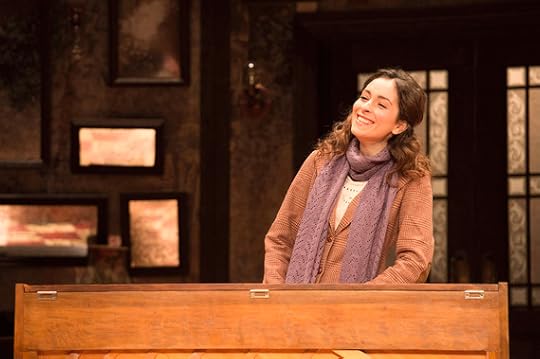
Image credits: Zrinka Cvitesic (Girl) in Once © Manuel Harlan
Once the Musical is a really warm, bittersweet show filled with Irish charm. Set in present-day Dublin, it is the story of Guy (Arthur Darvill), a broken-hearted, introverted musician and his fleeting affair of the heart with Girl (Zrinka Cvitesic), a spirited and wilful Czech woman who hears him busking.
A musician herself, Girl is moved by Guy's music but is distraught when at the end of his performance, Guy leaves his guitar behind, a sign that he is done with music. Girl is appalled and steps forward, desperate to cajole him into channelling his talents into producing a demo tape.
Guy though wants to be left alone to nurse his broken heart - his girlfriend having left the economic challenges of Dublin behind for a new life in New York without him - but Girl refuses. With her combination of blunt, direct Czech wit and her bright, bubbly personality, she wears down his defences and in the process, opens up his heart.
Modern-day Dublin really provides the spirit in this piece. As Girl and Guy pull together all the resources they need to fund a demo tape, they cross paths with a wide array of characters - both Irish (Dubliners and outsiders!) and Girl's circle of Czech family and friends who've come to Ireland in search of a better life for themselves.
Directed wonderfully by John Tiffany, the music is unequivocally a strength in the show and every piece generated a prolonged round of applause from the audience. All original songs, the pieces vary from the foot-stomping joyful Irish folk music to melancholic a cappella harmonies.
And though this is a musical, the book written by award-winning Irish playwright and screenwriter Enda Walsh is very funny, with plenty of dry, sharp wit to keep this piece from being overly-sentimental.
Certainly with its heavy emphasis on folksy charm and national authenticity, Once does flirt with being too twee and clichéd - the feisty Czech mother who gives Guy the once over when he comes to visit is quite a one-dimensional character, and Girl's best friend, a tough, hard-nosed woman, who offers to seduce another character who can help with band practice only if there's something in it for her, comes very, very close to being quite an ugly stereotype of Eastern European women.
But there is enough heart and depth in the actors and the story to keep Once just about on the right path.
A highlight is the set design (Bob Crowley), which is simple but deceptively brilliant. The interior of a Dublin pub makes up the single set of the show. But with its low lighting and its walls covered with wooden-framed mirrors that reflect the drama back into the room, the intimacy is retained beautifully.
There have been some recent changes in cast - Darvill has taken over the lead role but the celebrated Zrinka Cvitesic remains and she really is the heart and soul of the production. Her bright personality that masks her own breaking heart as she falls in love with Guy - a man she can't have - dominates the show.
It must be hard for Darvill to come in to an established production, even though he has played the role on Broadway. Certainly at times his character was a bit lost, overwhelmed by the others. I expect it will become easier for him as he feels more at home with the established West End cast but he has a wonderful voice and brought heartfelt emotion to his musical numbers.
Cvitesic gives a star turn, for sure, but each of the 12 adult members of the cast work so hard throughout the show. They rarely leave the stage and each one seems to have the ability to play a variety of instruments - drums, guitars, violins, cellos... The talent is superb. And not only do they complement the leads with their music but also with some truly fine harmonies and quite wonderful choreography and movement.
With its touching storyline, fine cast and original music, it's easy to see why the show has gained so many nominations in the upcoming 2014 Olivier Awards - an impressive six in total - including Best New Musical and Best Actress in a Musical.
This hasn't been a kind time for musicals, with high profile productions such as Stephen Ward: The Musical and From Here to Eternity struggling, so it's lovely to see such an unassuming but original piece succeed.
I'm not usually one for musicals but Once won me over for sure - it is funny, tender and heartfelt.
Phoenix Theatre, London
To July 4, 2015
Published on April 03, 2014 04:41



